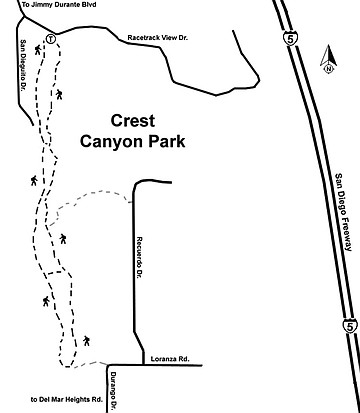 Facebook
Facebook
 X
X
 Instagram
Instagram
 TikTok
TikTok
 Youtube
Youtube

Crest Canyon Open Space Park was originally intended to be part of the Torrey Pines State Reserve Extension but was eliminated because of the cost of acquisition. It is now managed by the City of San Diego and is part of the San Dieguito River Park. This open space has southern and northern entrances. The recommended route is the trailhead beginning at the lower (or northern) end of Crest Canyon.
Follow the wide, gently sloping path up from the San Dieguito Lagoon through coastal sage scrub vegetation, including California sagebrush, buckwheat, black and white sage, goldenbush, toyon, California sunflower, Mexican elderberry, cudweed aster, and telegraph weed. Many young Torrey pines have taken hold in the shelter of this bowl-shaped canyon and have grown as large as those found in the Torrey Pines Extension. From the bowl of the canyon, note the Mojave yucca and prickly pear that can be seen on the slope to the right.
Summer is a good time to look for the abundant number of small mustard-yellow flowers of saltbush (Atriplex lentiformis) that grow in large gray-green clumps. Saltbush, a halophyte (salt tolerant) plant, makes itself saltier than the surrounding alkaline soil. This allows the plant to draw in water. Excess salt is then extruded as crystals on the underside of the leaves. These crystals are visible to the naked eye. Another halophyte, alkali heath, has small pink flowers and is also found in the canyon.

In the middle of the canyon, about half way up, a large clump of arroyo willow indicates available water. Further along on the right, amid dense stands of lemonade berry, look for conical piles of sticks. These are wood-rat nests. At a wide open space by a park sign, steep wooden stairs to the left ascend to another entrance to the preserve off Durango Dr.
A little further on, the coast sage scrub transitions to chaparral. Brush becomes denser and the sandy trail is narrow and slippery. Tall tree poppies and mountain mahogany, easily identified in summer by its fruit with a feathery tail, occur here. On the downhill return to the trailhead, take the parallel trail to the right. It is higher up on the east side of the canyon and slightly steeper with a fine view of San Dieguito Lagoon and the Del Mar Fairgrounds. Rust colored Linda Vista sandstone caps the canyon walls. Look for bush mallow with its pink flowers, fuzzy-leafed yerba santa, a huge Torrey pine with a broken limb, and Del Mar manzanita — an endangered species. About two-thirds of the way back, abundant pickleweed lines the trail. This common salt-tolerant plant makes up most of the salt marsh and rarely occurs at such an elevation.
As you leave Crest Canyon Open Space and head back toward Jimmy Durante Dr., visit the small observation area that overlooks the lagoon. This is a great spot in winter to see egrets, ducks and other shore birds.


Crest Canyon Open Space Park was originally intended to be part of the Torrey Pines State Reserve Extension but was eliminated because of the cost of acquisition. It is now managed by the City of San Diego and is part of the San Dieguito River Park. This open space has southern and northern entrances. The recommended route is the trailhead beginning at the lower (or northern) end of Crest Canyon.
Follow the wide, gently sloping path up from the San Dieguito Lagoon through coastal sage scrub vegetation, including California sagebrush, buckwheat, black and white sage, goldenbush, toyon, California sunflower, Mexican elderberry, cudweed aster, and telegraph weed. Many young Torrey pines have taken hold in the shelter of this bowl-shaped canyon and have grown as large as those found in the Torrey Pines Extension. From the bowl of the canyon, note the Mojave yucca and prickly pear that can be seen on the slope to the right.
Summer is a good time to look for the abundant number of small mustard-yellow flowers of saltbush (Atriplex lentiformis) that grow in large gray-green clumps. Saltbush, a halophyte (salt tolerant) plant, makes itself saltier than the surrounding alkaline soil. This allows the plant to draw in water. Excess salt is then extruded as crystals on the underside of the leaves. These crystals are visible to the naked eye. Another halophyte, alkali heath, has small pink flowers and is also found in the canyon.

In the middle of the canyon, about half way up, a large clump of arroyo willow indicates available water. Further along on the right, amid dense stands of lemonade berry, look for conical piles of sticks. These are wood-rat nests. At a wide open space by a park sign, steep wooden stairs to the left ascend to another entrance to the preserve off Durango Dr.
A little further on, the coast sage scrub transitions to chaparral. Brush becomes denser and the sandy trail is narrow and slippery. Tall tree poppies and mountain mahogany, easily identified in summer by its fruit with a feathery tail, occur here. On the downhill return to the trailhead, take the parallel trail to the right. It is higher up on the east side of the canyon and slightly steeper with a fine view of San Dieguito Lagoon and the Del Mar Fairgrounds. Rust colored Linda Vista sandstone caps the canyon walls. Look for bush mallow with its pink flowers, fuzzy-leafed yerba santa, a huge Torrey pine with a broken limb, and Del Mar manzanita — an endangered species. About two-thirds of the way back, abundant pickleweed lines the trail. This common salt-tolerant plant makes up most of the salt marsh and rarely occurs at such an elevation.
As you leave Crest Canyon Open Space and head back toward Jimmy Durante Dr., visit the small observation area that overlooks the lagoon. This is a great spot in winter to see egrets, ducks and other shore birds.
Comments